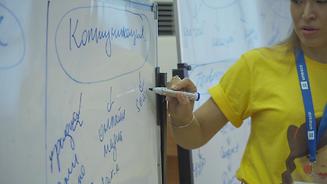29 September 2021
On 6 September 2021, the educational project "Qyz4Tabys", which in Kazakh means "a girl for success", was launched and dedicated to the International Literacy Day (September 8).
UNESCO, with the support of the Ministry of Foreign Affairs of the Republic of Kazakhstan, the youth wing "Zhas Otan", the Akimat of the Almaty region and the Akimat of the Panfilov region, has implemented a project on additional education for young girls from the city of Zharkent. The project aimed to develop the key skills and competencies of adolescent girls from rural areas to build their successful future, and reduce gender inequality in access to additional education.For five days, young project participants from the Zharkent Higher Humanitarian and Technical College underwent intensive trainings on career planning, financial literacy, project planning (using the UNESCO toolkit), youth entrepreneurship (focusing on the SDGs), as well as media and information literacy.
At the end of the trainings, all participants received certificates of the UNESCO standart and a full store of knowledge and self-confidence. Each of the 25 participants noted that this project completely changed their minds, career goals and plans for the future. In turn, the UNESCO team promised to further provide the necessary technical and mentoring support for the development of social projects and entrepreneurship.
In addition to teaching materials, theories and practices, the project participants were informed about additional opportunities for free education on the online platform CAYSPACE , participation in UNESCO youth programs, as well as opportunities for developing their capacity and leadership skills in the programs of other UN agencies.
Zharkent is an ancient city, and now the center of the Panfilov region, located in the border zone with China (South-East Kazakhstan). This city is inhabited by various ethnic groups, mainly Kazakhs, Uighurs, Dungans and Russians. The main type of income of the population is the collection and sale of corn, trade at the border, employment in agricultural enterprises. The uniqueness is that all cultures have peacefully intertwined in the history of the city since the days of the Great Silk Road. To this day, the architecture of some historic buildings, gastronomy, faith and mixed lifestyles testify to harmony and intercultural dialogue throughout the Panfilov region.
The UNESCO team decided to reflect all this in a short film about our project, and therefore, after the trainings, our team visited different places to capture real intercultural/interreligious relations in this region and in the city of Zharkent itself. We also spoke to many girls and women who shared their stories and told us about girls' lack of quality educational opportunities; challenges that young girls still face on the path to a brighter and more successful future in the region.
Additionally:
In 2020, UNESCO launched a free online platform CAYSPACE for the education of Central Asian youth. Today, around 2,000 young people from different parts of the region are trained in 12+ professional areas, improving their skills and competitiveness in the labor market.
One of the main priorities of this platform is to provide adolescent girls and young girls, in particular from rural and remote areas, with equal access to additional education. After all, today, there are significant differences in the ratio of participation of girls and boys in non-formal education, since girls from villages are less likely to receive additional vocational education at their request due to socio-cultural characteristics, such as early marriages, heavy burden of housework, child labor, early pregnancies and limited opportunities in choosing their life path. Other factors include the lack of additional education centers or a long distance to educational institutions, gender inequality, as well as gender-based violence at the family, community or school level.
Permanent link: http://en.unesco.kz/qyz4tabys-beginning-of-a-successful-future-for-young-girls-from-remote-and-rural-areas-of


